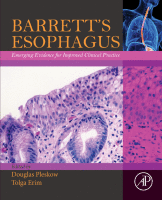Physical Address
304 North Cardinal St.
Dorchester Center, MA 02124

15.1 Introduction Endoscopic eradication therapy (EET), either using endoscopic resection (ER) or radiofrequency ablation (RFA), cryoablation, or a combination of resection and ablation, aims not only to completely eliminate Barrett’s esophagus (BE) dysplasia and early neoplasia but also a complete…

14.1 Introduction Barrett’s esophagus (BE) is an acquired condition in which a metaplastic columnar epithelium replaces the stratified squamous epithelium that normally lines the distal esophagus . Metaplasia commonly is a consequence of chronic inflammation, and intestinal metaplasia results from…

13.1 Introduction Earlier chapters in this book describe how ablative therapies have essentially replaced surgery for the management of Barrett’s esophagus (BE) with high-grade dysplasia (HGD). However, resectional therapies, performed either with flexible endoscopy or surgery, are still required for…

12.1 Introduction Endoscopic cryospray ablation or cryotherapy is a unique method of ablation that offers physicians a versatile choice in the treatment of Barrett’s and early esophageal cancer. The concept of endoscopic cryospray ablation began in the late 1990s with…

11.1 Introduction Barrett’s esophagus (BE) occurs when an abnormal, intestinal-type epithelium called “specialized intestinal metaplasia” replaces the stratified squamous epithelium that normally lines the distal esophagus. The condition develops as a consequence of chronic gastroesophageal reflux disease and predisposes to…

10.1 Introduction A general outline of this chapter includes a brief background followed by historical trends of endoscopic ablation (with the exception of radiofrequency ablation and cryospray ablation, which are covered in chapter 11, chapter 12 : Radiofrequency Ablation and…

9.1 Introduction Barrett’s esophagus (BE) is associated with the risk of development of esophageal adenocarcinoma. Current surveillance according to the Seattle protocol includes white light endoscopy (WLE) with the collection of random four-quadrant biopsy specimens over every 1–2 cm of…

8.1 Introduction Optical coherence tomography (OCT) is an optical analog of ultrasound imaging that was invented in the early 1990s . OCT fills a resolution gap between confocal laser endomicroscopy (CLE) and ultrasound, affording the capability of visualizing architectural microscopic…

7.1 Introduction The incidence of adenocarcinoma of the esophagus is increasing more rapidly than any other type of carcinoma in the United States . Almost 100% of cases occur in patients with Barrett’s esophagus (BE) , a benign condition in…

6.1 Overview Five decades after the British surgeon Norman Barrett first described the condition that bears his name, the true incidence of Barrett’s esophagus (BE) in the general population and the risk of progression to cancer continue to be areas…